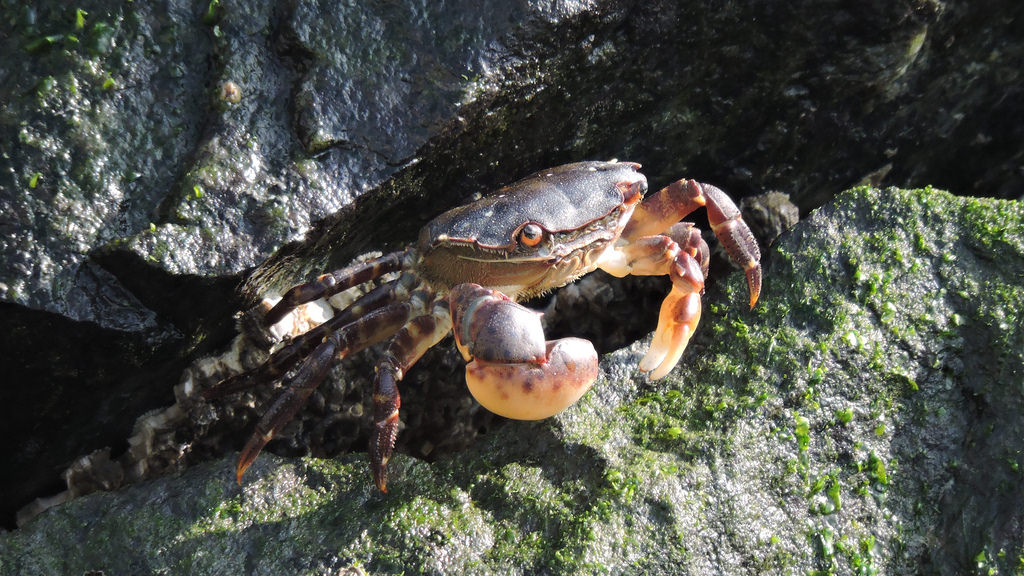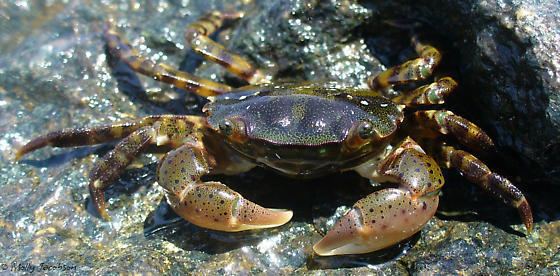Asian Shore Crab Kingdom
3 crabs per meter squared to greater than 80 crabs per meter squared in Asian shore crab density at three sites in southern New England Lohrer 2002. Hemigrapsus sanguineus may compete.

Hemigrapsus Sanguineus Alchetron The Free Social Encyclopedia
Diet feeding preferences and overlap with the green crab Carcinus maenas.

Asian shore crab kingdom. First record of the Asian shore crab Hemigrapsus sanguineus De Haan 1835 in Belgium Crustacea Brachyura Grapsoidea. Sanguineus is a relatively small intertidal shore crab native to cobbleboulder coastlines in the western Pacific Ocean from Hong Kong Island to Sakhalin Island China Japan Korea Russia 22 N to 49 N Sakai 1976. The Asian Shore Crab Hemigrapsus sanguineus - was first identified on American shores in New Jersey in 1988.
To understand the potential effects of H. The crab spread rapidly after its discovery and breeding populations currently extend. De huidige status van Hemigrapsus sanguineus de Haan 1835 en.
As it invades this new habitat it is likely to interact with a number of important salt marsh species. The species was first observed in North America near Delaware Bay 39N 75W in 1988 and a variety of evidence suggests initial introduction via ballast water early in that decade. It has a very broad diet and in its introduced range has the potential to affect populations of native species such as crabs fish and shellfish by disrupting the food web.
The Asian shore crab also referred to as the Japanese shore crab Hemigrapsus sanguineus de Haan 1835 is a native species of the North-West Pacific coast with a recorded distribution from China Hong Kong Taiwan Korea Russia and Japan Sakai Reference Sakai 1976. It also occupies habitats very similar to native mud crabs. There were many more Asian shore crabs than green crabs found at each site.
Dai Yang 1991. The Asian shore crab Hemigrapsus sanguineus is native to coastal and estuarine habitat along the east coast of Asia. MBP list An Asian Shore Crab in Barnstable Massachusetts 612008.
Two recent predatory invaders along European shores the Asian shore crab Hemigrapsus sanguineus De Haan 1835 and the Asian brush-clawed crab Hemigrapsus takanoi Asakura Watanabe 2005 may have the potential for strong effects on native competitors and prey species. The Asian shore crab Hemigrapsus sanguineus has a negative influence on the mussel consumption of the European green crab and thus its resulting growth rates. Asian boy is holding a crab in philippines palawan el nido - asian shore crab stock pictures royalty-free photos images Crabs Near the Waters Edge circa 1830.
Hemigrapsus sanguineusDe Haan Asian Shore Crab colonized eastern North America in the 1980s near Cape May NJ Williams and McDermott 1990 likely in ship ballast from Japan Blakeslee et al. Photo by Keith Eric Costley. The invasive Asian shore crab Hemigrapsus sanguineus has recently been observed occupying salt marshes a novel environment for this crab species.
Its since made its way as far north as Schoodic Point Maine and as far south as North Carolina. There is a distinctive banding pattern present on the legs and the claws are speckled. As adults they only reach 15 inches in length.
Since it reproduces so fast there is a high chance that these species will become outnumbered and. This crab was first reported outside of its native area by Williams. In September 1988 it was found in Townsends Inlet New Jersey USA Williams and McDermott 1990.
It has been introduced to several other regions and is now an invasive species in North America and Europe. Dai et al Reference Dai Yang Song and Chen 1986. Sanguineus on this ecosystem interactions between this invasive.
Native to the western Pacific the newcomers were first sighted in European coastal. Dai et al 1986. Potential impact of the introduced Asian shore crab Hemigrapsus sanguineus in Northern New England.
The Asian shore crab also affects this species by consuming settling post-larvae and displacing juveniles from their refuge habitat under rocks Griffen Guy Buck 2008. Hemigrapsus sanguineus the Japanese shore crab or Asian shore crab is a species of crab from East Asia. It was introduced to these regions by ships from Asia emptying their ballast tanks in coastal waters.
The females are capable of producing 50000 eggs per clutch with 3-4 clutches per breeding season. The crab is indigenous to waters from southern Russia to Hong Kong The. For you seafood lovers or even fisherman and other people that make their livings off of selling fish for consumption the Asian Shore Crab can greatly affect you.
The Asian Shore Crab eats lobster larvae blue crabs and other species that are highly popular for consumption. The juvenile stage is very small and hard to identify. It has been introduced to several other shores and is now an invasive species in North America and Europe.
De Haan Common Names. 2015 Kraemer et al. Asian shore crab Japanese shore crab.
The Asian shore crab and the green crab interact aggressively with one another in competition over food and shelter. The tiny little balls made by crab on the langkawi beach langkawi malaysia - asian shore crab stock pictures royalty-free photos images This picture taken on October 20 2018 shows a newborn green turtle after being released at a beach on Thameehla Island. An Asian Shore Crab at the Ocean City Inlet in Worcester Co Maryland 12122015.
Summary of Invasiveness. Because of this the larvae. It is expected to continue moving northward along the Maine coast.
Hemigrapsus sanguineus the Japanese shore crab or Asian shore crab is a species of crab from East Asia. The Asian shore crab also referred to as the Japanese shore crab Hemigrapsus sanguineus de Haan 1835 is a native species of the North-West Pacific coast with a recorded distri-bution from China Hong Kong Taiwan Korea Russia and Japan Sakai 1976. Hemigrapsus sanguineus is commonly called the Asian shore crab and is native to the Asia-Pacific region.
Varunidae - Thoracotrematan crab family. Their coloration can range from orange-brown to green or even purple. The larvae are suspended in the water for approximately one month before developing into juvenile crabs.
These small crabs are identified by a square-shaped shell and three spines on each side of the carapace. Photo by Robert Aguilar SERC. Its range has since expanded into Maine and population sizes have increased Bloch et al.
Dai Yang Reference Dai and Yang 1991. The Asian shore crab is highly reproductive with a breeding season from May to September twice the length of native crabs. Another possibility is to utilize.

Hemigrapsus Sanguineus Alchetron The Free Social Encyclopedia
Asian Shore Crab New York Invasive Species Information

Photos Of Asian Shore Crab Hemigrapsus Sanguineus Inaturalist
Posting Komentar untuk "Asian Shore Crab Kingdom"